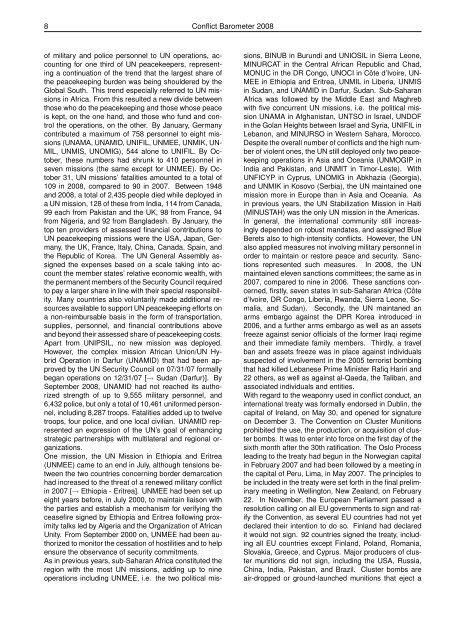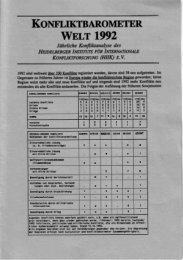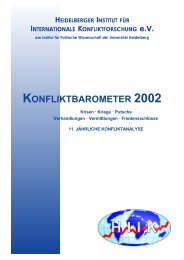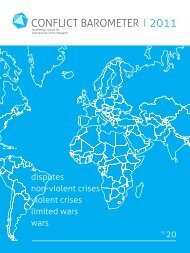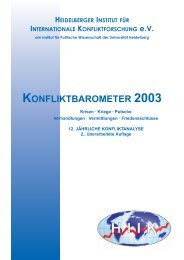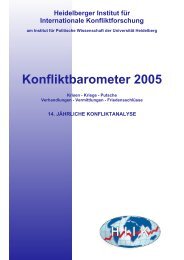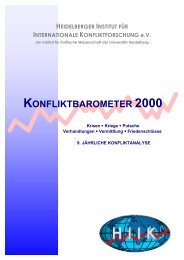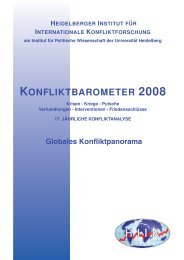CONFLICT BAROMETER 2008
CONFLICT BAROMETER 2008
CONFLICT BAROMETER 2008
Create successful ePaper yourself
Turn your PDF publications into a flip-book with our unique Google optimized e-Paper software.
8 Conflict Barometer <strong>2008</strong><br />
of military and police personnel to UN operations, accounting<br />
for one third of UN peacekeepers, representing<br />
a continuation of the trend that the largest share of<br />
the peacekeeping burden was being shouldered by the<br />
Global South. This trend especially referred to UN missions<br />
in Africa. From this resulted a new divide between<br />
those who do the peacekeeping and those whose peace<br />
is kept, on the one hand, and those who fund and control<br />
the operations, on the other. By January, Germany<br />
contributed a maximum of 758 personnel to eight missions<br />
(UNAMA, UNAMID, UNIFIL, UNMEE, UNMIK, UN-<br />
MIL, UNMIS, UNOMIG), 544 alone to UNIFIL. By October,<br />
these numbers had shrunk to 410 personnel in<br />
seven missions (the same except for UNMEE). By October<br />
31, UN missions’ fatalities amounted to a total of<br />
109 in <strong>2008</strong>, compared to 90 in 2007. Between 1948<br />
and <strong>2008</strong>, a total of 2,435 people died while deployed in<br />
a UN mission, 128 of these from India, 114 from Canada,<br />
99 each from Pakistan and the UK, 98 from France, 94<br />
from Nigeria, and 92 from Bangladesh. By January, the<br />
top ten providers of assessed financial contributions to<br />
UN peacekeeping missions were the USA, Japan, Germany,<br />
the UK, France, Italy, China, Canada, Spain, and<br />
the Republic of Korea. The UN General Assembly assigned<br />
the expenses based on a scale taking into account<br />
the member states’ relative economic wealth, with<br />
the permanent members of the Security Council required<br />
to pay a larger share in line with their special responsibility.<br />
Many countries also voluntarily made additional resources<br />
available to support UN peacekeeping efforts on<br />
a non-reimbursable basis in the form of transportation,<br />
supplies, personnel, and financial contributions above<br />
and beyond their assessed share of peacekeeping costs.<br />
Apart from UNIPSIL, no new mission was deployed.<br />
However, the complex mission African Union/UN Hybrid<br />
Operation in Darfur (UNAMID) that had been approved<br />
by the UN Security Council on 07/31/07 formally<br />
began operations on 12/31/07 [→ Sudan (Darfur)]. By<br />
September <strong>2008</strong>, UNAMID had not reached its authorized<br />
strength of up to 9,555 military personnel, and<br />
6,432 police, but only a total of 10,461 uniformed personnel,<br />
including 8,287 troops. Fatalities added up to twelve<br />
troops, four police, and one local civilian. UNAMID represented<br />
an expression of the UN’s goal of enhancing<br />
strategic partnerships with multilateral and regional organizations.<br />
One mission, the UN Mission in Ethiopia and Eritrea<br />
(UNMEE) came to an end in July, although tensions between<br />
the two countries concerning border demarcation<br />
had increased to the threat of a renewed military conflict<br />
in 2007 [→ Ethiopia - Eritrea]. UNMEE had been set up<br />
eight years before, in July 2000, to maintain liaison with<br />
the parties and establish a mechanism for verifying the<br />
ceasefire signed by Ethiopia and Eritrea following proximity<br />
talks led by Algeria and the Organization of African<br />
Unity. From September 2000 on, UNMEE had been authorized<br />
to monitor the cessation of hostilities and to help<br />
ensure the observance of security commitments.<br />
As in previous years, sub-Saharan Africa constituted the<br />
region with the most UN missions, adding up to nine<br />
operations including UNMEE, i.e. the two political missions,<br />
BINUB in Burundi and UNIOSIL in Sierra Leone,<br />
MINURCAT in the Central African Republic and Chad,<br />
MONUC in the DR Congo, UNOCI in Côte d’Ivoire, UN-<br />
MEE in Ethiopia and Eritrea, UNMIL in Liberia, UNMIS<br />
in Sudan, and UNAMID in Darfur, Sudan. Sub-Saharan<br />
Africa was followed by the Middle East and Maghreb<br />
with five concurrent UN missions, i.e. the political mission<br />
UNAMA in Afghanistan, UNTSO in Israel, UNDOF<br />
in the Golan Heights between Israel and Syria, UNIFIL in<br />
Lebanon, and MINURSO in Western Sahara, Morocco.<br />
Despite the overall number of conflicts and the high number<br />
of violent ones, the UN still deployed only two peacekeeping<br />
operations in Asia and Oceania (UNMOGIP in<br />
India and Pakistan, and UNMIT in Timor-Leste). With<br />
UNFICYP in Cyprus, UNOMIG in Abkhazia (Georgia),<br />
and UNMIK in Kosovo (Serbia), the UN maintained one<br />
mission more in Europe than in Asia and Oceania. As<br />
in previous years, the UN Stabilization Mission in Haiti<br />
(MINUSTAH) was the only UN mission in the Americas.<br />
In general, the international community still increasingly<br />
depended on robust mandates, and assigned Blue<br />
Berets also to high-intensity conflicts. However, the UN<br />
also applied measures not involving military personnel in<br />
order to maintain or restore peace and security. Sanctions<br />
represented such measures. In <strong>2008</strong>, the UN<br />
maintained eleven sanctions committees; the same as in<br />
2007, compared to nine in 2006. These sanctions concerned,<br />
firstly, seven states in sub-Saharan Africa (Côte<br />
d’Ivoire, DR Congo, Liberia, Rwanda, Sierra Leone, Somalia,<br />
and Sudan). Secondly, the UN maintaned an<br />
arms embargo against the DPR Korea introduced in<br />
2006, and a further arms embargo as well as an assets<br />
freeze against senior officials of the former Iraqi regime<br />
and their immediate family members. Thirdly, a travel<br />
ban and assets freeze was in place against individuals<br />
suspected of involvement in the 2005 terrorist bombing<br />
that had killed Lebanese Prime Minister Rafiq Hariri and<br />
22 others, as well as against al-Qaeda, the Taliban, and<br />
associated individuals and entities.<br />
With regard to the weaponry used in conflict conduct, an<br />
international treaty was formally endorsed in Dublin, the<br />
capital of Ireland, on May 30, and opened for signature<br />
on December 3. The Convention on Cluster Munitions<br />
prohibited the use, the production, or acquisition of cluster<br />
bombs. It was to enter into force on the first day of the<br />
sixth month after the 30th ratification. The Oslo Process<br />
leading to the treaty had begun in the Norwegian capital<br />
in February 2007 and had been followed by a meeting in<br />
the capital of Peru, Lima, in May 2007. The principles to<br />
be included in the treaty were set forth in the final preliminary<br />
meeting in Wellington, New Zealand, on February<br />
22. In November, the European Parliament passed a<br />
resolution calling on all EU governments to sign and ratify<br />
the Convention, as several EU countries had not yet<br />
declared their intention to do so. Finland had declared<br />
it would not sign. 92 countries signed the treaty, including<br />
all EU countries except Finland, Poland, Romania,<br />
Slovakia, Greece, and Cyprus. Major producers of cluster<br />
munitions did not sign, including the USA, Russia,<br />
China, India, Pakistan, and Brazil. Cluster bombs are<br />
air-dropped or ground-launched munitions that eject a


